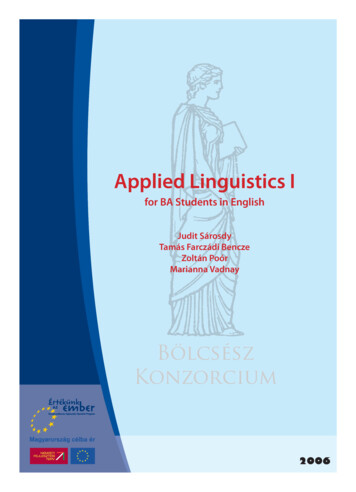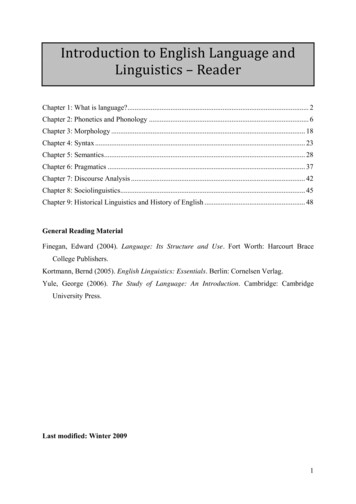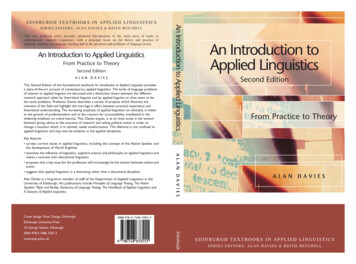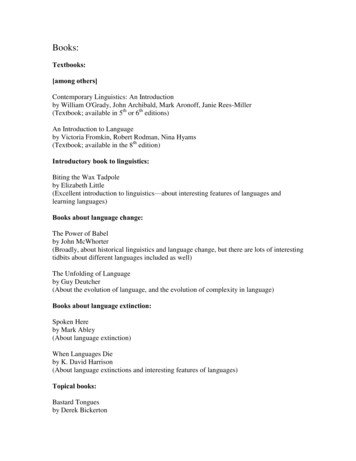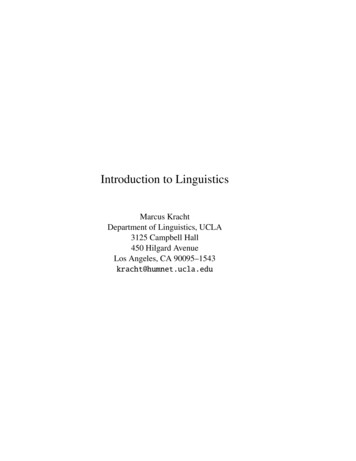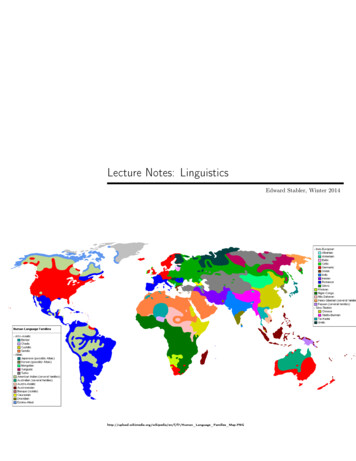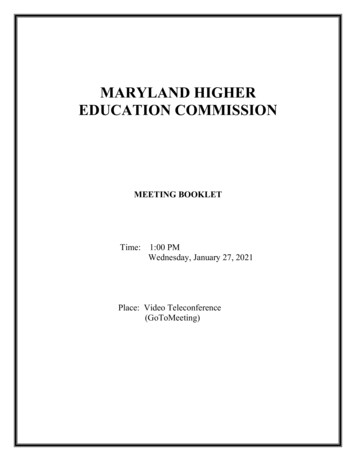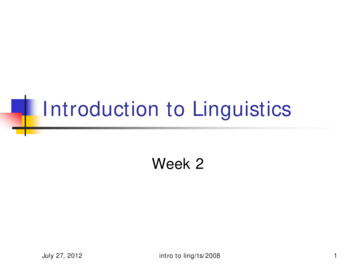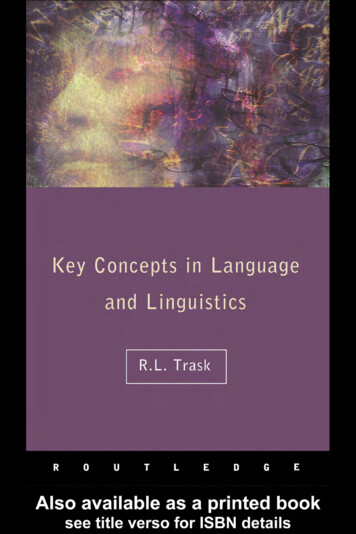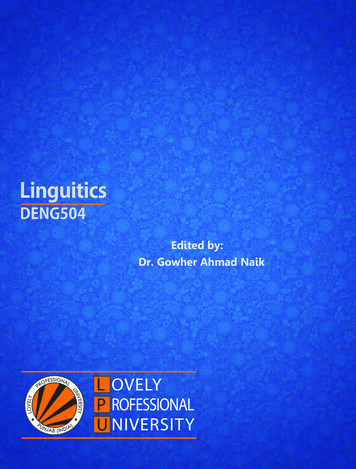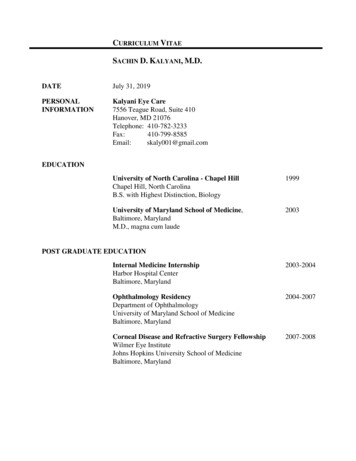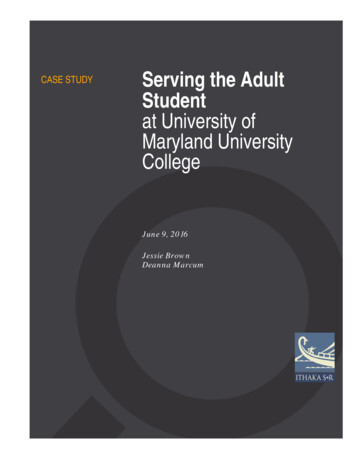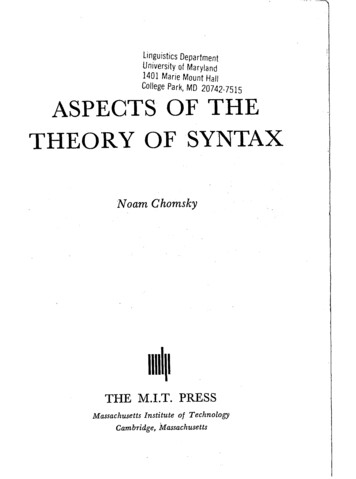
Transcription
Linguistics DepartmentUniversity of Maryland1401 Marie Mount HallCollege Park, MD 20742-7515ASPECTS OF T H ETHEORY OF SYNTAXNoam ChomskyTHE M.I.T. PRESSMassachusetts Institute of TechnologyCambridge, assachusetts
ACKNOWLEDGMENTThis is Special Technical Report Number 1 I of the Research Laboratory of Electronics of the Massachusetts Institute of Technology.The 'Research Laboratory of Electronics is an interdepartmentallaboratory-in which faculty members and graduate studentsfrom numerous academic departments conduct research.The research reported in this document was made possible in part bysupport extended the Massachusetts Institute of Technology, ResearchLaboratory of Electronics, by the JOINT SERVICES ELECTRONICS PROGRAMS(U.S. Army, U.S. Navy, and U.S. Air Force) under Contract No. DAg6039-AMC-ogzoo(E); additional support was received from the U.S. AirForce (Electronic Systems Division under Contract AFig(628)-2487).the National Science Foundation (Grant GI?-2495) the National Institutes of Health (Grant MH-04737-04), and The National Aeronauticsand Space Administration (Grant NsG-496). eproductionin whole or in part isfor any purpose of theUnited States Government.Copyright @ 1965byThe Massachusetts Institute of TechnologyAll Rights ReservedFourteenth printing, 1985Library of Congress Catalog Card Number: 65-19080Printed in the United States of America
PrefaceT h e idea that a language is based on a system of rules determining the interpretation of its infinitely many sentences is byno means novel. Well over a century ago, it was expressed withreasonable clarity by Wilhelm von Humboldt in his famous butrarely studied introduction to general linguistics (Humboldt,1836). His view that a language "makes infinite use of finitemeans" and that its grammar must describe the processes thatmake this possible is, furthermore, an outgrowth of a persistentconcern, within rationalistic philosophy of language and mind,with this "creative" aspect of language use (for discussion, seeChomsky, 1964, forthcoming). What is more, it seems that evenPanini's grammar can be interpreted as a fragment of such a"generative grammar," in essentially the contemporary sense ofthis term.Nevertheless, within modern linguistics, i t is chiefly withinthe last few years that fairly substantial attempts have been madeto construct explicit generative grammars for particular languages and to explore their consequences. No great surpriseshould be occasioned by the extensive discussion and debateconcerning the proper formulation of the theory of generativegrammar and the correct description of the languages that havebeen most intensively studied. The tentative character of anyconclusions that can now be advanced concerning linguistictheory, or, for that matter, English grammar, should certainlybe obvious to anyone working in this area. (It is sufficient to
VIPREFACEconsider the vast range of linguistic phenomena that have resisted insightful formulation in any terms.) Still, it seems thatcertain fairly substantial conclusions are emerging and receivingcontinually increased support. I n particular, the central role ofgrammatical transformations in any empirically adequate generative grammar seems to me to be established quite firmly,though there remain many questions as to the proper formof the theory of transformational grammar.This monograph is an exploratory study of various problemsthat have arisen in the course of work on transformational grammar, which is presupposed throughout as a general frameworkfor the discussion. What is at issue here is precisely how thistheory should be formulated. This study deals, then, with questions that are at the border of research in transformational grammar. For some, definite answers will be proposed; but moreoften the discussion will merely raise issues and consider possible approaches to them without reaching any definite conclu1i.on. In Chapter 3, 1 shall sketch briefly what seems to me, in thelight of this discussion, the most promising direction for thetheory of generative grammar to take. But I should like to reiterate that this can be only a highly tentative proposal.The monograph is organized in the following way. Chapter Isketches background assumptions. I t contains little that is new,but aims only to summarize and to clarify certain points thatare essential and that in some instances have been repeatedlymisunderstood. Chapters a and 3 deal with a variety of defectsin earlier versions of the theory of transformational grammar.The position discussed is that of Chomsky (1957). Lees (1960a),and many others. These writers take the syntactic componentof a transformational grammar to consist of a phrase structuregrammar as its base, and a system of transformations that mapstructures generated by the base into actual sentences. This position is restated briefly at the beginning of Chapter 3. Chapter ais concerned with the base of the syntactic component, and withdifficulties that arise from the assumption that it is, strictlyspeaking, a phrase structure grammar. Chapter 3 suggests a revision of the transformational component and its relation to base
PREFACEviistructures. The notion of "grammatical transformation" itselfis taken over without change (though with some simplifications).I n Chapter 4, various residual problems are raised, and discussedbriefly and quite inconclusively.I should like to acknowledge with gratitude the very helpfulcomments of many friends and colleagues who have taken thetrouble to read earlier versions of this manuscript. I n particular,I am indebted to Morris Halle and Paul Postal, who have suggested many valuable improvements, as well as to Jerrold Katz,James McCawley, George Miller, and G. H. Matthews; and tomany students whose reactions and ideas when this material hasbeen presented have led to quite substantial modifications.The writing of this book was completed while I was at HarvardUniversity, Center for Cognitive Studies, supported in part byGrant No. MH 05120-04 and -05 from the National Institutes ofHealth to Harvard University, and in part by a fellowship of theAmerican Council of Learned Societies.NOAMCHOMSICYCambridge, MassachusettsOctober 1964
ContentsPreface1 Methodological PreliminariesGENERATIVE GRAMMARS AS THEORIES O F LINGUISTIC COMPETENCETOWARD A THEORY O F PERFORMANCET H E ORGANIZATION O F A GENERATIVE GRAMMARJUSTIFICATION O F GRAMMARSFORMAL AND SUBSTANTIVE UNIVERSALSFURTHER REMARKS ON DESCRIPTIVE AND EXPLANATORY THEORIESON EVALUATION PROCEDURESLINGUISTIC THEORY AND LANGUAGE LEARNINGGENERATIVE CAPACITY AND ITS LINGUISTIC RELEVANCE2 Categories and Relations in Syntactic Theory 631. T H E SCOPE O F T H E BASE2. ASPECTS O F DEEP STRUCTUREÂ2.1.82.2.CategorizationFunctional notionsIX63646468
CONTENTS2.3.3.4.Syntactic features5 2.3.1. The problem 755 2.3.2. Some formal similarities between syntax79and phonology2.3.3. General structure of the base component2.34. Context-sensitive subcategorization rulesAN ILLUSTRATIVE FRAGMENT OF THE BASE COMPONENT106TYPES OF BASE RULESI l l5 4.1. Summary5 4.2. Selectional rules and grammatical relations5 4.3. Further remarks o n subcategorization rules5 4.4. T h e role of categorial rules3 Deep Structures and GrammaticalTransformations4 Some Residual Problems1. THE BOUNDARIES OF SYNTAX AND SEMANTICSDegrees of grammaticalnessFurther remarks o n selectional rules1.3. Some additional problems of semantictheory1.1.551.2.2. THE STRUCTURE OF THE LEXICON5 2.1. Redundancy5 2.2. Inflectional processes5 2.3. Derivational 10
ASPECTS O F THETHEORY O F SYNTAX
Methodological PreliminariesI.GENERATIVE GRAMMARS AS THEORIES OFLINGUISTIC COMPETENCETHISstudy will touch on a variety of topics in syntactictheory and English syntax, a few in some detail, several quitesuperficially, and none exhaustively. It will be concerned withthe syntactic component of a generative grammar, that is, withthe rules that specify the well-formed strings of minimal syntactically functioning units (formatives) and assign structuralinformation of various kinds both to these strings and to stringsthat deviate from well-formedness in certain respects.T h e general framework within which this investigation willproceed has been presented in many places, and some familiaritywith the theoretical and descriptive studies listed in the bibliography is presupposed. I n this chapter, I shall survey briefly someof the main background assumptions, making no serious attempthere to justify them but only to sketch them clearly.Linguistic theory is concerned primarily with an ideal speakerlistener, in a completely homogeneous speech-community, whoknows its language perfectly and is unaffected by such gramrnatically irrelevant conditions as memory limitations, distractions,shifts of attention and interest, and errors (random or characteristic) in applying his knowledge of the language in actual performance. This seems to me to have been the position of thefounders of modern general linguistics, and no cogent reason for
4METHODOLOGICAL PRELIMINARIESmodifying it has been offered. T o study actual linguistic performance, we must consider the interaction of a variety of factors,of which the underlying competence of the speaker-hearer isonly one. In this respect, study of language is no different fromempirical investigation of other complex phenomena.We thus make a fundamental distinction between competence(the speaker-hearer's knowledge of his language) and performance(the actual use of language in concrete situations). Only underthe idealization set forth in the preceding paragraph is performance a direct reflection of competence. In actual fact, itobviously could not directly reflect competence. A record ofnatural speech will show numerous false starts, deviations fromrules, changes of plan in mid-course, and so on. The problemfor the linguist, as well as-for the child learning the language, isto determine from the data of performance the underlying systemof rules that has been mastered by the speaker-hearer and thathe puts to use in actual performance. Hence, in the technicalsense, linguistic theory is mentalistic, since it is concerned withdiscovering a mental reality underlying actual behavior.l Observed use of language or hypothesized dispositions to respond,habits, and so on, may provide evidence as to the nature of thismental reality, but surely cannot constitute the actual subjectmatter of linguistics, if this is to be a serious discipline. Thedistinction I am noting here is related to the langue-paroledistinction of Saussure; but it is necessary to reject his concept oflangue as merely a systematic inventory of items and to returnrather to the Humboldtian conception of underlying competenceas a system of generative processes. For discussion, see Chomsky(1964).A grammar of a language purports to be a description of theideal speaker-hearer's intrinsic competence. If the grammar is,furthermore, perfectly explicit - in other words, if it does notrely on the intelligence of the understanding reader but ratherprovides an explicit analysis of his contribution-wemay(somewhat redundantly) call it a generative grammar.A fully adequate grammar must assign to each of an infiniterange of sentences a structural description indicating how thisI
1. GENERATIVE GRAMMARS AND LINGUISTIC COMPETENCE5sentence is understood by the ideal speaker-hearer. This is thetraditional problem of descriptive linguistics, and traditionalgrammars give a wealth of information concerning structuraldescriptions of sentences. However, valuable as they obviouslyare, traditional grammars are deficient in that they leave unexpressed many of the basic regularities of the language withwhich they are concerned. This fact is particularly clear on thelevel of syntax, where no traditional or structuralist grammargoes beyond classification of particular examples to the stage offormulation of generative rules on any significant scale. Ananalysis of the best existing grammars will quickly reveal thatthis is a defect of principle, not just a matter of empirical detailor logical preciseness. Nevertheless, it seems obvious that theattempt to explore this largely uncharted territory can mostprofitably begin with a study of the kind of structural informationpresented by traditional grammars and the kind of linguisticprocesses that have been exhibited, however informally, inthese grammars.2The limitations of traditional and structuralist grammarsshould be clearly appreciated. Although such grammars maycontain full and explicit lists of exceptions and irregularities, theyprovide only examples and hints concerning the regular andproductive syntactic processes. Traditional linguistic theory wasnot unaware of this fact. For example, James Beattie (1788)remarks thatLanguages, therefore, resemble men in this respect, that, though eachhas peculiarities, whereby it is distinguished from every other, yet allhave certain qualities in common. The peculiarities of individualtongues are explained in their respective grammars and dictionaries.Those things, that all languages have in common, or that are necessaryto every language, are treated of in a science, which some have calledUniversal or Philosophical grammar.Somewhat earlier, Du Marsais defines universal and particulargrammar in the following way (1729; quoted in Sahlin, 1928,PP. 29-30):I1 y a dans la grammaire des observations qui convihnnent 5 toutesles langues; ces observations torment ce qu'on appelle la grammaire
6METHODOLOGICAL PRELIMINARIESgtohale: telles sont les remarques que l'on a faites sur les sons articulks,sur les lettres qui sont les signes de ces sons; sur la nature des mots, etsur les differentes maniferes dont ils doivent fitre ou arranges ou termindspour faire un sens. Outre ces observations generales, il y en a qui nesont propres qu'i une langue particulifere; et c'est ce qui forme les grammaires particuli6res'de chaque langue.Within traditional linguistic theory, furthermore, it was clearlyunderstood that one of the qualities that all languages have incommon is their "creative" aspect. Thus an essential property oflanguage is that it provides the means for expressing indefinitelymany thoughts and for reacting appropriately in an indefiniterange of new situations (for references, cf. Chomsky, 1964, forthcoming). T h e grammar of a particular language, then, is to besupplemented by a universal grammar that accommodates thecreative aspect of language use and expresses the deep-seatedregularities which, being universal, are omitted from thegrammar itself. Therefore it is quite proper for a grammar todiscuss only exceptions and irregularities in any detail. I t is onlywhen supplemented by a universal grammar that the grammarof a language provides a full account of the speaker-hearer'scompetence.Modern linguistics, however, has not explicitly recognized thenecessity for supplementing a "particular grammar" of a language by a universal grammar if it is to achieve descriptiveadequacy. I t has, in fact, characteristically rejected the studyof universal grammar as misguided; and, as noted before, it hasnot attempted to deal with the creative aspect of language use.I t thus suggests no way to overcome the fundamental descriptiveinadequacy of structuralist grammars.Another reason for the failure of traditional grammars,particular or universal, to attempt a precise statement of regularprocesses of sentence formation and sentence interpretation layin the widely held belief that there is a "natural order ofthoughts" that is mirrored by the order of words. Hence, therules of sentence formation do not really belong to grammar butto some other subject in which the "order of thoughts" isstudied. Thus in the Grammaire gMrale et raisonnke (Lancelot
1. GENERATIVE GRAMMARS AND LINGUISTIC COMPETENCE7et al., 1660) it is asserted that, aside from figurative speech, thesequence of words follows an "ordre naturel," which conforms"A l'expression naturelle de nos penskes." Consequently, few grammatical rules need be formulated beyond the rules of ellipsis,inversion, and so on, which determine the figurative use of language. The same view appears in many forms and variants. T omention just one 'additional example, in an interesting essaydevoted largely to the question of how the simultaneous andsequential array of ideas is reflected in the order of words, Diderotconcludes that French is unique among languages in the degreeto which the order of words corresponds!to the natural order ofthoughts and ideas (Diderot, 1751). Thus "quel que soit l'ordredes termes dans une langue ancienne ou moderne, l'esprit del'kcrivain a suivi l'ordre didactique de la syntaxe franqaise"(p. 390); "Nous disons les choses en fran ais,comme l'esprit estforck de les considkrer en quelque langue qu'on derive" (p. 371).With admirable consistency he goes on to conclude that "notrelangue pkdestre a sur les autres l'avantage de Futile surl'agrkable" (p. 372); thus French is appropriate for the sciences,whereas Greek, Latin, Italian, and English "sont plus avantageuses pour les lettres." Moreover,le bons sens choisirait la langue francaise; mais . . l'imagination et lespassions donneront la pr6fkence aux-'langues anciennes et A celles denos voisins . il faut parler francais dans la soci6t6 et dans les 6colesde philosophie; et grec, latin, anglais, dans les chaires et sur les th6Anotre langue sera celle de la v6rit6, si jamais elle revient .surtres;la terre; etla grecque, la latine et les autres seront les langues de lafable et du mensonge. Le francais est fait pour instruire, 6clairer et convaincre; le grec, Ie latin, l'italien, l'anglais, pour persuader, 6mouvoir ettromper: parlez grec, latin, italien au peuple; mais parlez francais ausage- (PP- 371-3721I n any event, insofar as the order of words is determined byfactors independent of language, it is not necessary to describeit in a particular or universal grammar, and we therefore haveprincipled grounds for excluding an explicit formulation ofsyntactic processes from grammar. I t is worth noting that thisnaive view of language structure persists to modem times in. .
8METHODOLOGICAL PRELIMINARIESvarious forms, for example, in Saussure's image of a sequence ofexpressions corresponding to an amorphous sequence of conceptsor in the common characterization of language use as merely amatter of use of words and phrases (for example, Ryle, 1953).But the fundamental reason for this inadequacy of traditionalgrammars is a more technical one. Although it was well understood that linguistic processes are in some sense "creative," thetechnical devices for expressing a system of recursive processeswere simply not available until much more recently. I n fact, areal understanding of how a language can (in Humboldt's words)"make infinite use of finite means" has developed only withinthe last thirty years, in the course of studies in the foundations ofmathematics. Now that these insights are readily available it ispossible to return to the problems that were raised, but notsolved, in traditional linguistic theory, and to attempt an explicitformulation of the "creative" processes of language. There is,in short, no longer a technical barrier to the full-scale study ofgenerative grammars.Returning to the main theme, by a generative grammar Imean simply a system of rules that in some explicit and welldefined way assigns structural descriptions to sentences. Obviously,every speaker of a language has mastered and internalized a generative grammar that expresses his knowledge of his language.This is not to say that he is aware of the rules of the grammar oreven that he can become aware of them, or that his statementsabout his intuitive knowledge of the language are necessarilyaccurate. Any interesting generative grammar will be dealing,for the most part, with mental processes that are far beyond thelevel of actual or eyen potential consciousness; furthermore, it isquite apparent that a speaker's reports and viewpoints about hisbehavior and his competence may be in error. Thus a generativegrammar attempts to specify what the speaker actually knows,not what he may report about his knowledge. Similarly, a theoryof visual perception would attempt to account for what a personactually sees and the mechanisms that determine this rather thanhis statements about what he sees and why, though these state-
1. GENERATIVE GRAMMARS AND LINGUISTIC COMPETENCE9ments may provide useful, in fact, compelling evidence forsuch a theory.T o avoid what has been a continuing misunderstanding, it isperhaps worth while to reiterate that a generative grammar isnot a model for a speaker or a hearer. I t attempts to characterizein the most neutral possible terms the knowledge of the languagethat provides the basis for actual use of language by a speakerhearer. When we speak of a grammar as generating a sentencewith a certain structural description, we mean simply that thegrammar assigns this structural description to the sentence.When we say that a sentence has a certain derivation with respectto a particular generative grammar, we say nothing about howthe speaker or hearer might proceed, in some practical orefficient way, to construct such a derivation. These questionsbelong to the theory of language use- the theory of performance. No doubt, a reasonable model of language use willincorporate, as a basic component, the generative grammar thatexpresses the speaker-hearer's knowledge of the language; butthis generative grammar does not, in itself, prescribe the character or functioning of a perceptual model or a model of speechproduction. For various attempts to clarify this point, seeChomsky (ig.t,7),Gleason (1961), Miller and Chomsky (1963), andmany other publications.Confusion over this matter has been sufficiently persistent tosuggest that a terminological change might be in order. Nevertheless, I think that the term "generative grammar" is completelyappropriate, and have therefore continued to use it. The term"generate" is familiar in the sense intended here in logic,particularly in Post's theory of combinatorial systems. Furthermore, "generate" seems to be the most appropriate translationfor Humboldt's term erzeugen, which he frequently uses, it seems,in essentially the sense here intended. Since this use of the term"generate" is well established both in logic and in the traditionof linguistic theory, I can see no reason for a revision ofterminology.
102.METHODOLOGICAL PRELIMINARIEST O W A R D A T H E O R Y OF PERFORMANCEThere seems to be little reason to question the traditional viewthat investigation of performance will proceed only so faras understanding of underlying competence permits. Furthermore, recent work on performance seems to give new support tothis assumption. T o my knowledge, the only concrete resultsthat have been achieved and the only clear suggestions that havebeen put forth concerning the theory of performance, outside ofphonetics, have come from studies of performance models thatincorporate generative grammars of specific kinds -that is, fromstudies that have been based on assumptions about underlyingcompetence.3 I n particular, there are some suggestive observationsconcerning limitations on performance imposed by organizationof memory and bounds on memory, and concerning the exploitation of grammatical devices to form deviant sentences ofvarious types. The latter question is one to which we shall returnin Chapters 2 and 4. T o clarify further the distinction betweencompetence and performance, it may be useful to summarizebriefly some of the suggestions and results that have appeared inthe last few years in the study of performance models with limitations of memory, time, and access.For the purposes of this discussion, let us use the term "acceptable" to refer to utterances that are perfectly natural andimmediately comprehensible without paper-and-pencil analysis,and in no way bizarre or outlandish. Obviously, acceptabilitywill be a matter of degree, along various dimensions. One couldgo on to propose various operational tests to specify the notionmore precisely (for example, rapidity, correctness, and uniformityof recall and recognition, normalcy of intonation).4 For presentpurposes, it is unnecessary to delimit it more carefully. T o illustrate, the sentences of (I) are somewhat more acceptable, in theintended sense, than those of (a):(I) (i) I called up the man who wrote the book that you told meabout(ii) quite a few of the students who you met who come fromNew York are friends of mine
2. TOWARD A THEORY OF PERFORMANCE11(iii) John, Bill, Tom, and several of their friends visited uslast night(a) (i) I called the man who wrote the book that you told meabout up(ii) the man who the boy who the students recognized pointedout is a friend of mineThe more acceptable sentences are those that are more likely tobe produced, more easily understood, less clumsy, and in somesense more natural.5 The unacceptable sentences one would tendto avoid and replace by more acceptable variants, whereverpossible, in actual discourse.The notion "acceptable" is not to be confused with "grammatical." Acceptability is a concept that belongs to the study ofperformance, whereas grammaticalness belongs to the study ofcompetence. The sentences of (2) are low on the scale of ac-.ceptability but high on the scale of grammaticalness, in thetechnical sense of this term. That is, the generative rules of thelanguage assign an interpretation to them in exactly the way inwhich they assign an interpretation to the somewhat more acceptable sentences of (I). Like acceptability, grammaticalness is,no doubt, a matter of degree (cf. Chomsky, 1955, 1957, 1961), butthe scales of grammaticalness and acceptability do not coincide.Grammaticalness is only one of many factors that interact todetermine acceptability. Correspondingly, although one mightpropose various operational tests for acceptability, it is unlikelythat a necessary and sufficient operational criterion might beinvented for the much more abstract and far more importantnotion of grammaticalness. The unacceptable grammatical sentences often cannot be used, for reasons having to do, not withgrammar, but rather with memory limitations, intonational andstylistic factors, "iconic" elements of discourse (for example, atendency to place logical subject and object early rather thanlate; cf. note 32, Chapter 2, and note 9, Chapter 3), and so on.Note that it would be quite impossible to characterize the unacceptable sentences in grammatical terms. For example, we cannot formulate particular rules of the grammar in such a way as
METHODOLOGICAL PRELIMINARIESto exclude them. Nor, obviously, can we exclude them by limitingthe number of reapplications of grammatical rules in the generation of a sentence, since unacceptability can just as well arisefrom application of distinct rules, each being applied only once.In fact, it is dear that we can characterize unacceptable sentencesonly in terms of some "global" property of derivations and thestructures they define - a property that is attributable, not to aparticular rule, but rather to the way in which the rules interrelate in a derivation.This observation suggests that the study of performance couldprofitably begin with an investigation of the acceptability of thesimplest formal structures in grammatical sentences. The mostobvious formal property of utterances is their bracketing intoconstituents of various types, that is, the "tree structure" associated with them. Among such structures we can distinguishvarious kinds - for example, those to which we give the following conventional technical names, for the purposes of thisdiscussion:(3) (i)(ii)(iii)(iv)(v)nested constructionsself-embedded constructionsmultiple-branching constructionsleft-branching constructionsright-branching constructionsThe phrases A and B form a nested construction if A fallstotally within B, with some nonnull element to its left within Band some nonnull element to its right within B. Thus the phrase"the man who wrote the book that you told me about" is nestedin the phrase "called the man who wrote the book that you toldme about up," in (ai). The phrase A is self-embedded in B if Ais nested in B and, furthermore, A is a phrase of the same typeas B. Thus "who the students recognized" is self-embedded in"who the boy who the students recognized pointed out," in (aii),since both are relative clauses. Thus nesting has to do withbracketing, and self-embedding with labeling of brackets as well.A multiple-branching construction is one with no internalstructure. In ( iii),the Subject Noun Phrase is multiple-branch-1
2. TOWARD A THEORY OF PERFORMANCEI3ing, since "John," "Bill," "Tom," and "several of their friends"are its immediate constituents, and have no further associationamong themselves. In terms of bracketing, a multiple-branchingconstruction has the form [[A][B] [Afl]. A left-branching structure is of the form [[[- -1 -1 * .] - for example, in English, suchindefinitely iterable structures as [[[[Johnl'sbrother]'! fatherl'suncle] or [[[theman who you met] from Boston] who was on thetrain], or (lii), which combines several kinds of left-branching.Right-branching structures are those with the opposite property-for example, the Direct-Object of (ii) or [this is [the catthat caught [the rat that stole the cheese]]].The effect of these superficial aspects of sentence structure onperformance has been a topic of study since almost the veryinception of recent work on generative grammar, and there aresome suggestive observations concerning their role in determining acceptability (that is, their role in limiting performance).Summarizing this work briefly, the following observations seemplausible:- -----(4) (i) repeated nesting co
The position discussed is that of Chomsky (1957). Lees (1960a), and many others. These writers take the syntactic component of a transformational grammar to consist of a phrase structure grammar as its base, and a system of transformations that map structure
